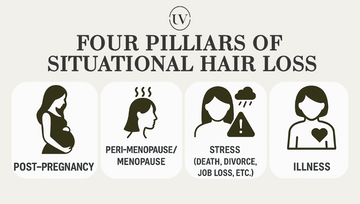Situational Hair Loss in Women: 4 Common Causes and How to Recover Naturally
by Meghan O'Malley

Situational Hair Loss in Women: 4 Common Causes and How to Recover Naturally
Understanding the cause of your hair loss is the first step toward healing. If your shedding started suddenly or after a life event, you might be dealing with situational hair loss—a temporary condition caused by stress, illness, hormonal shifts, or trauma. The good news? Your hair can often grow back with time and the right care.
The 4 Most Common Causes of Situational Hair Loss in Women
1. Postpartum Hair Loss
After giving birth, many women experience a noticeable increase in shedding. This is called postpartum hair loss, and it typically begins 2–4 months after delivery.
During pregnancy, high estrogen levels keep hair in a prolonged growth phase. Once hormone levels drop postpartum, all that paused hair enters the shedding phase at once. While this process is normal, it can feel dramatic and emotional.
2. Hair Loss from Illness or Medical Treatment
Whether you’re recovering from thyroid issues, an autoimmune condition, or chemotherapy, your body may redirect energy away from non-essential functions like hair growth.
This can trigger telogen effluvium, a form of temporary shedding that typically begins 2–3 months after the illness or treatment. Hair may feel finer and thinner all over the scalp.
3. Menopause or Perimenopause Hair Thinning
Hormonal shifts during perimenopause and menopause often cause hair to grow more slowly, shed more easily, and feel noticeably thinner—especially around the crown and temples.
As estrogen declines, testosterone can become more dominant, shortening the growth cycle and shrinking hair follicles. This leads to finer, weaker strands and more visible scalp over time.
4. Hair Loss from Stress
Emotional trauma, grief, burnout, or job loss—your body doesn’t differentiate emotional stress from physical injury. Unfortunately, one of the first places that stress shows up is on your scalp.
Stress-related shedding usually starts 2–3 months after the stressful event. While this hair loss is temporary, the emotional impact can be long-lasting.
When to Take Action + What to Expect
If your hair loss started suddenly and aligns with any of the causes above, you may be experiencing telogen effluvium—a temporary condition that often reverses once the underlying issue improves.
However, if shedding continues for more than 6–12 months, or you begin to notice visible scalp or patchy loss, it’s best to consult a specialist to rule out other types of hair loss or medical conditions.
Support Hair Growth from the Inside Out
At Unveil Haircare, we believe real results start at the root. Our clean, sulfate-free formulas are designed to support scalp health and strengthen hair follicles—because we’ve lived through hair loss, too.
Whether you’re recovering from postpartum, stress, or illness, our Hair Growth Essentials Kit is a science-backed, easy-to-use starting point for fuller, healthier hair.
Shop the Essentials Kit That Supports Hair Recovery
You deserve to feel like yourself again. Let’s help your hair get there.




